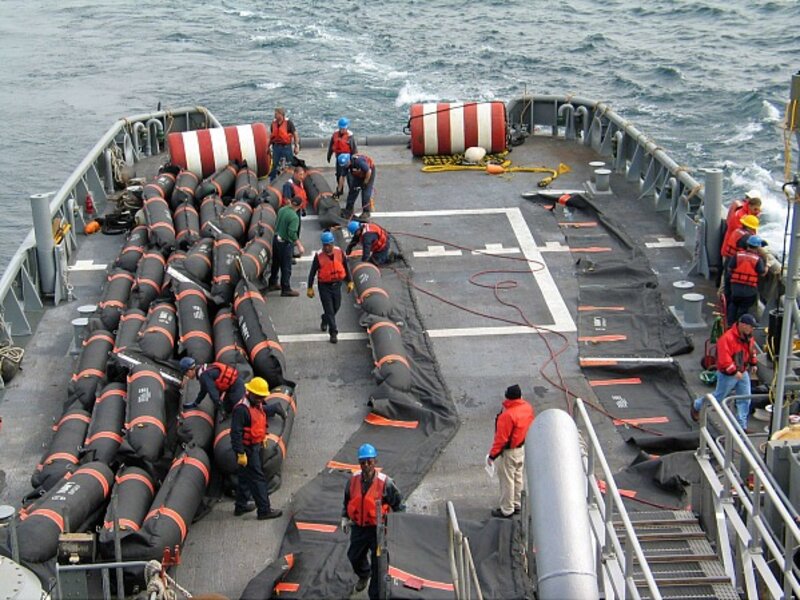Gulf of Mexico oil spill: Once again, US military gets the call
Loading...
| Washington
The Gulf of Mexico oil spill once again puts the US military in the role of white knight, as it provides assistance in the cleanup and state officials look to it to pay the bill.
The Pentagon’s response so far has been limited in the wake of the massive oil spill off the coast of Louisiana – two Air Force C-130 Hercules military airplanes and a smattering of logistical support and equipment from the US Navy.
But the deployment underscores how the military has come to be known as the “go-to" agency in the US government when crises arise. From the tsunami in Asia to the earthquake in Haiti and dozens of other, smaller emergencies, the military increasingly gets the 3 a.m. call.
IN PICTURES: Louisiana oil spill
It comes down to the vast resources of the Pentagon, which this year has a $708 billion base-line budget request. That allows for the largest standing pool of personnel from which to draw when a crisis arises – and the money to pay for it.
Louisiana governor Bobby Jindal probably had that in mind when he requested Friday that Defense Secretary Robert Gates pay for the deployment of the Louisiana National Guard to help protect the shore if and when the oil slick reaches the coastline.
President Obama said Friday that ultimately BP, which owns the sunken oil rig, is responsible for paying for the cleanup. But in the short term, the Pentagon has the purse to pay for the deployments and the capabilities needed right now.
“The fact is that the only thing you can throw at a problem immediately is the guy in the uniform,” says one analyst who didn’t want to be named but has studied federal responses to emergencies and believes the military will always be prepared to go.
Impact on military readiness
From time to time, the sheer number of these kinds of deployments raises questions about how they affect military readiness. The response to Haiti, which at its height included as many as 22,000 active-duty service members either on the island or floating offshore, did pose a challenge to the military just as it was preparing to deploy a surge of forces to Afghanistan.
But typically, these kinds of relief operations do not undermine military readiness, says Larry Korb, a senior fellow at the Center for American Progress, a liberal think tank in Washington. Instead, they have secondary positive effects.
In the wake of the Asian tsunami, the military played a lead role, sending some 25 ships, 57 helicopters, 45 fixed-wing aircraft, and more than 16,000 people. The relief efforts the military conducted had a real impact. It also represented a positive diplomatic payoff, especially at a time when the US is waging two campaigns in Muslim countries.
“What you saw is basically that the opinion of the United States in the world’s largest Muslim country skyrocketed,” notes Mr. Korb, a senior Pentagon official in the Reagan administration. “That’s very, very important.”
In the Pentagon’s inner “A Ring,” there is a hallway that exhibits the dizzying number of humanitarian and other relief efforts in which the US military made major contributions.
The most recent, of course, is Haiti. But the military’s efforts span back decades, to include the eruption of Mt. Pinatubo in the Philippines, the Midwest floods in the US in 1993, and New England’s nor’easter in 1978.
In March 1989, the US military responded after the Exxon Valdez ran aground in Prince William Sound, Alaska, spewing 11 million gallons of crude oil. A Marine Corps detachment from San Diego was soon dispatched and later a bevy of CH-46 Sea Knight helicopters to conduct medevacs and search-and-rescue operations. Two Navy amphibious ships, the USS Juneau and the USS Fort McHenry, also responded.
Good public relations
The public-relations effects of a response such as the one in 1989 help send a positive message to a domestic audience too, says Korb.
During the current crisis, Secretary Gates approved the use of two KC-130 aircraft to use modular aerial spray systems, or MASS, to disperse the oil slick. More may be sent if needed over the weekend.
“Right now, we have committed to what has been identified as being needed,” said Pentagon spokesman Geoff Morrell. “As the situation evolves, there could be other stuff that is identified and we would provide.”
Through standing agreement with the US Coast Guard, the Navy is providing logistical support and equipment to the oil-spill efforts. The service has sent 66,000 feet of inflatable oil boom with mooring equipment, skimming systems, and about 50 contractors to support cleanup efforts.
But for all the resources and capabilities of the US military, it doesn’t have a magic wand, either.
“There are no silver bullets in the Department of Defense that can fix this situation,” Mr. Morrell said.
IN PICTURES: Louisiana oil spill
Related:
US sends aircraft carrier to help with Haiti earthquake damage





